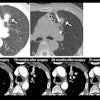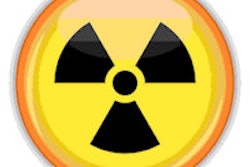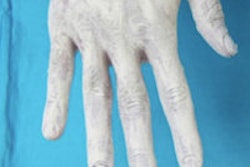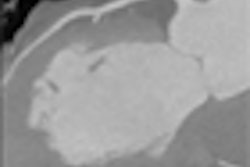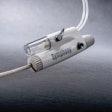Many patients at hospitals in developing countries may be getting too much radiation dose during interventional radiology and cardiology procedures, according to a study sponsored by the International Atomic Energy Agency (IAEA) and published in the August issue of the American Journal of Roentgenology.
The study surveyed the use of interventional radiology at hospitals in Eastern Europe, Africa, and Asia, finding that some facilities don't have the proper equipment to track radiation dose in patients, and for some interventional procedures, more than half of patients received dose levels that exceed guidelines in developed countries. The lead author on the paper was Virginia Tsapaki, Ph.D., of Konstantopoulio Hospital in Attiki, Greece (AJR, August 2009, Vol. 193:2, pp. 559-569).
On the positive side, the study represents an important step in developing a systematic method for monitoring interventional radiation dose in the developing world -- a method that's lacking in many more developed countries. In addition, the survey found that sites in the developing world did a good job in adopting radiation protection measures for healthcare personnel.
Skyrocketing use
The use of interventional x-ray in the developing world has been skyrocketing in recent years as hospitals acquire more sophisticated imaging equipment and the staff expertise needed to operate it. The study found that some 30% of the countries surveyed had experienced a 100% increase in interventional procedures over the past three years.
The trend has drawn the attention of the IAEA, a Vienna, Austria-based agency within the United Nations that has among its responsibilities the task of overseeing regulatory efforts in the field of radiation-based medicine. In 2005, the agency launched a series of projects in regions around the world to improve radiation protection in medical procedures. The current study is part of that effort.
The study's goal was to survey interventional radiology and cardiology procedures in different countries, and to identify weaknesses that could be addressed through education and staff training. The researchers surveyed 55 hospitals in 20 developing countries, with nine mostly in Eastern Europe, five in Africa, and six in Asia.
The research included interventional radiology and cardiology sites, with surveys conducted starting in early 2006 and finishing in early 2008 to collect information on radiation protection procedures and measuring dose delivered during imaging studies. They used two methods to record dose -- kerma-area product (KAP, a recently developed term at the IAEA to replace dose-area product, or DAP) using KAP meters installed in interventional suites, as well as dosimetry film.
The KAP meters were used to estimate the kerma-area product, which directly relates to the risk of developing cancer from a procedure decades later. The dosimetry film measures the risk of developing radiation-induced skin injury, a more short-term injury.
The dosimetry film (Gafchromic, International Specialty Products, Wayne, NJ) was irradiated along with patients, and the optical density of the exposed film was then compared to an established reference level to determine the peak skin dose (PSD) of radiation to which the patient had been exposed.
Due to the cost of the Gafchromic film ($18 per exam), sites were told only to measure dose in patients who were likely to be undergoing fluoroscopy for more than 30 minutes. Because of this, the study's results with dosimetry film tend to reflect the experience of patients undergoing longer interventional radiology procedures, rather than the entire spectrum of interventional studies, according to senior author Madan Rehani, radiation safety specialist at IAEA.
For the procedures where dosimetry film was used, the researchers collected data on 505 patients. They found that 20% had PSD exceeding the 2-Gy threshold for erythema, a redness of the skin that can be caused by exposure to ionizing radiation. Of these, 4.6% were in the range of 4 Gy to less than 6 Gy, and 2% were in the range of 6 Gy to less than 10 Gy. No skin injuries were reported, although the researchers said that this could not be ruled out due to a "lack of awareness" among interventionalists.
For the sites using KAP meters, only 1% (30/2,070) of all interventional procedures exceeded levels thought to trigger skin erythema. However, 62% of percutaneous transluminal coronary angioplasty (PTCA) procedures were above European dose reference levels and, thus, could be optimized, the researchers said.
Raising awareness
In discussing the results, the researchers noted that cardiologists, in particular, were unaware of dose levels generated during interventional procedures. But this situation is also found in developed countries, and in many cases, such as France, Spain, and Germany, governments have implemented auditing programs to monitor dose.
The survey did find good levels of compliance with established radiation safety procedures for healthcare personnel. Lead aprons were commonly used at all hospitals in the survey (100%), and 80% of countries reported monitoring staff dose with dosimeters. Lead protective glasses for eye protection were used by 73% of operators, and 57% of facilities had internally installed KAP meters. Only 4% of staff reported that either the equipment operator (cardiologist or radiologist) or radiographer did not routinely have a dosimeter during procedures.
The researchers concluded by recommending the following:
- KAP meters should be installed in all x-ray equipment for patient dose monitoring.
- Staff should use lead glass eyewear and lead aprons in 100% of cases.
- Two dosimeters should be used per staff employee, one mounted over the lead apron at the collar level and the other under the lead apron at chest level.
According to Rehani, the study indicates that while dose levels in the developing world are not yet optimal, the IAEA is making progress in its campaign to raise dose awareness. He believes that educational initiatives such as the one described in the study are often more effective than heavy-handed government regulations that are often ignored by healthcare personnel.
Rehani also pointed out that some developed countries have never undertaken a study of this scale to measure interventional radiation dose.
"I feel that these countries [in the study] are going to be ahead of developed countries," Rehani said. "Even if their dose values are higher, they at least know where they stand, whereas many developed countries haven't looked into it."
By Brian Casey
AuntMinnie.com staff writer
August 5, 2009
Related Reading
IAEA urges scheme to track radiation in patients, April 30, 2009
ARRS studies: Education reduces imaging volume, dose, April 23, 2009
NCRP report: CT drives massive increase in medical radiation dose, March 3, 2009
Global radiation dose higher than necessary, June 3, 2008
Radiation burns 'often' iatrogenic - UN, May 10, 2004
Copyright © 2009 AuntMinnie.com


